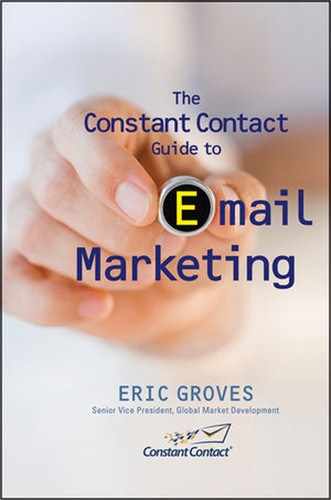Ten Keys to Your Overall Email Marketing Success
If you learn nothing else from this book, I recommend you master the following ten principles. Most of the statistics that suggest high returns on email marketing investment depend on how closely you adhere to these basics.
1. Only send email to people who know you. People open email from people they know, and they delete email from people they don’t recognize or mark it as spam. It doesn’t even matter what’s legal or ethical. If your business makes a habit of emailing total strangers, then your reputation, your budget, and your growth will suffer for it. You can read about building a good email list in Chapter 5.
2. Don’t treat email addresses like email addresses; treat them like relationships. An email address is one of the most personal things someone can share with your business because it’s an invitation to send your messages to a place where he or she sends and receives personal communications as well as business ones. Email doesn’t work if it feels like a computer-generated HTML document. It has to come across as being part of a meaningful relationship. You can read about building relationships in Chapter 2.
3. Send relevant content that has value to your recipient. You probably weren’t going to send irrelevant, valueless content on purpose, but content with good intentions isn’t the same thing as value and relevance. In order to ensure that your emails are valuable and relevant, you have to know exactly what your audience wants. You have to be a good listener to be a good communicator. You can find more about creating relevance and value in your content in Chapter 7.
4. Engage your audience in the content you write. This requires attention-grabbing subject lines, clear headlines, and thoughtful content. You can read about what makes email content engaging in Chapter 7.
5. Maximize your delivery rate. Getting email delivered is harder than you might think. Internet Service Providers (“ISPs”) such as Yahoo!, AOL, and Hotmail work diligently to block emails from unwanted senders. If your email isn’t up to professional standards in reputation, technology, or permission, you might as well be sending your email directly to the junk folder. You can read about maximizing delivery in Chapter 11.
6. Don’t share email lists with anyone. Your email list is a valuable asset. It will lose value if you loan it to someone else because the people on your list won’t recognize a foreign sender. You should never borrow an email list from someone else. That list is full of people who aren’t familiar with your business, and you are likely to attract more enemies than friends. You can read about protecting your email list in Chapter 6.
are likely to attract more enemies than friends. You can read about protecting your email list in Chapter 6.
Figure 1.1 Avoiding the junk folder is one of the keys to successful email marketing.

7. Set expectations with your recipients. When someone signs up to receive your email communications, they do so with the expectation of receiving something of value. If you don’t communicate clearly what that value is, your audience will draw their own conclusions. Tell your audience what you’ll be sending and how often you’ll be sending it. That way, you’ll defeat any value, relevance, and frequency objections before your audience even signs up. You can read more about setting expectations in Chapter 4.
8. Look professional whenever you communicate. If you’re a salesperson, you know how to dress for success. Similarly, if you’re an email, you need to look familiar, inviting, and consistent. You can read more about creating an email with a friendly professional identity in Chapter 9.
9. Be ready to respond. Email communications can be highly automated, in an off-putting way that distances you from your customers. Don’t set an email auto reply in your in-box and take a mental vacation. Keep an eye on your communications and your responses so you can take action, make changes, and repeat positive results. You can read more about responding to your emails in Chapter 12.
10. Regularly review your campaign results. The longer you practice marketing the more you realize how unpredictable your results will be if you don’t analyze your past and make adjustments based on your data. Use email tracking reports to help you improve, progress, and grow. You can read about email tracking reports in Chapter 12.
..................Content has been hidden....................
You can't read the all page of ebook, please click here login for view all page.
